Let’s be honest—once you’ve had a hamburger wrapped in a soft, chewy sourdough bun with that golden crust and signature tang… it’s game over for store-bought buns. Those pillowy-soft supermarket guys just don’t stand a chance.
Sourdough hamburger buns are a glow-up for any backyard burger bash, weekday dinner, or random Tuesday when you’re craving something that feels a little fancy but is surprisingly simple. They’ve got that magical sourdough flavor, they hold up beautifully to juicy patties and sauce overload, and yep—they make you feel like a total kitchen boss.
But wait, isn’t sourdough baking, like… super complicated?
Not really. And this guide is here to make it fun, fail-proof, and full of flavor (plus a few bread puns—you’ve been warned 🥖😉).
Whether you’re a seasoned sourdough nerd or a “I-just-named-my-starter-Karen” beginner, you’ll learn exactly how to whip up golden, bakery-style hamburger buns right at home.
Let’s roll!
Why Sourdough?
Sourdough isn’t just some fancy baking trend your neighbor Karen (or your starter) brags about. It’s been around for thousands of years, and for good reason—it’s tasty, gut-friendly, and gives your buns a boost in both texture and shelf life.
🍞 1. That Signature Tang
The slight sourness in sourdough comes from lactic acid bacteria doing their thing during fermentation. It adds complexity and depth—basically, sourdough buns taste like they were made on purpose, not in a factory.
💪 2. Easier on Your Belly
The long fermentation process helps break down gluten and phytic acid, making sourdough easier to digest for some folks. Plus, it’s a slow-fermented food, and those are known for their probiotic perks.
🧊 3. Stay Fresh Longer
Thanks to their natural acidity, sourdough buns tend to resist staling and mold better than typical yeasted ones. Translation: you won’t have to eat six buns in two days or cry over moldy bread.
💧 4. Moisture Retention = No Soggy Sadwiches
Sourdough holds moisture like a champ, which means your bun stays chewy and your burger doesn’t turn into a soggy mess. Major win.
Ingredients You’ll Need for Sourdough Hamburger Buns
Good news: You probably already have most of these in your kitchen. Great buns don’t require fancy stuff, just the right techniques.
🧑🍳 The Basics
- Active sourdough starter (fed and bubbly)
Think of this as the MVP of your recipe. You’ll want it at peak activity for best rise and flavor. - Bread flour
High protein = more gluten = stronger structure. You could use all-purpose, but bread flour gives better chew. - Whole wheat flour (optional)
Adds flavor and a slightly nuttier bite. You can sub in 10–20% of the total flour if you’re feelin’ fancy. - Milk
Helps soften the crumb and enrich the dough. - Butter
For richness and that melt-in-your-mouth feel. - Sugar or honey
A touch of sweetness helps balance the sour flavor. Honey adds a deeper flavor, but both work great. - Salt
Don’t skip it. It balances flavors and strengthens the gluten structure. - Egg (optional)
Adds richness and color, especially if you brush it on top before baking.
Equipment & Setup (coming in next part)
We’ll dive into the tools and tricks in the next section—nothing too wild, just some helpful gear and cozy-proofing tips to set you up for success.
Equipment & Setup
You don’t need a Michelin-starred kitchen to bake amazing sourdough buns, but a few handy tools can make life a whole lot easier. Here’s your sourdough squad:
| Tool | Why You Need It |
|---|---|
| Mixing Bowl | For combining your ingredients. Any big bowl will do. |
| Kitchen Scale | Accuracy = better buns. Way more reliable than guessing with cups. |
| Bench Scraper | Helps you shape and move dough without sticking. Also makes you look legit. |
| Dough Whisk or Sturdy Spoon | To mix ingredients evenly, especially when the dough gets sticky. |
| Damp Towel or Plastic Wrap | Covers the dough while it rises, so it doesn’t dry out. |
| Parchment Paper | Helps avoid sticking during baking and makes cleanup a breeze. |
| Baking Sheet or Cast Iron Skillet | Your baking surface. A pizza stone works too. |
| Oven Thermometer (optional) | Ensures your oven is actually the temp it claims to be. |
| Kitchen Timer | Because, let’s be honest, you’ll get distracted by TikTok. |
| Warm Spot | Your dough’s cozy nap zone. A turned-off oven with the light on works great. |
💡 Pro Tip: If your kitchen is chilly, microwave a mug of water for 2 minutes, then pop your covered bowl in the warm microwave (door closed). Instant proofing chamber!
Step-by-Step: How to Make Perfect Sourdough Hamburger Buns
Now for the good stuff—let’s make these golden beauties! Here’s a friendly visual of each stage to help you track your progress:
🥯 Sourdough Hamburger Buns Timeline (Table View)
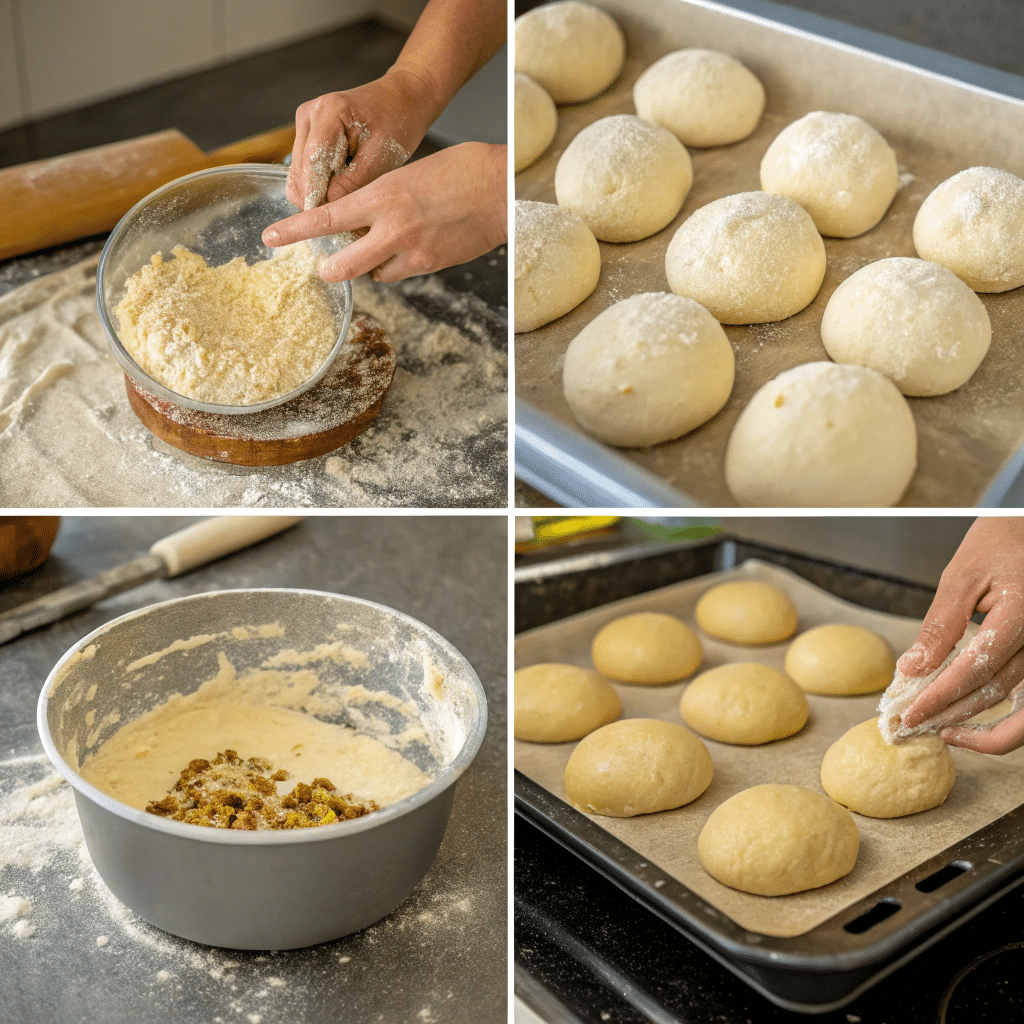
| Step | Action | What to Look For / Tips |
|---|---|---|
| 1. Feed Starter | Feed your sourdough starter 4–6 hours before baking | Should be bubbly, doubled in size, and pass the float test |
| 2. Mix Dough | Combine starter, flour, milk, sugar, and butter | Dough should be sticky but hold together |
| 3. Autolyse (Optional) | Let dough rest for 30 minutes before adding salt | Helps flour fully hydrate and gluten start developing |
| 4. Add Salt & Mix | Add salt, knead a little | Dough gets more elastic; don’t over-knead |
| 5. Bulk Fermentation | Let rise 4–6 hours at room temp, with stretch & folds every 30–45 mins | Dough should be smooth, puffy, not flat |
| 6. Divide & Shape | Divide into 6–8 equal balls, shape into tight rounds | Tension on top = better rise |
| 7. Final Proof | Let shaped buns rest 1–2 hours (or overnight in fridge) | Should be slightly puffy and jiggle when poked |
| 8. Bake | 375°F (190°C) for 20–25 mins until golden brown | Internal temp: ~200°F (93°C); golden top, firm bottom |
Visual Cheatsheet: Dough Progression
| Dough Stage | Look | Feel |
|---|---|---|
| Just Mixed | Rough, sticky | Shaggy, like cookie dough |
| After Folds | Smoother, still soft | Elastic and tacky |
| Proofed | Puffy, slightly domed | Airy, soft when pressed |
| Post-Bake | Golden, crackled crust | Light, firm structure inside |
Common Pitfalls & How to Fix Them
Sourdough is part art, part science, and—let’s be real—part patience. Here are some rookie mistakes people make with Sourdough Hamburger Buns (and how to rescue them before they go full pancake 🫠).
⚠️ 1. Flat Buns
Cause: Under-proofing or over-proofing (yep, both can flatten your vibe).
Fix: Watch for the “poke test”—lightly press the dough. If it springs back too quickly, it needs more time. If it stays dented and deflates, you’ve over-proofed. Aim for a slow, partial bounce.
⚠️ 2. Dense Texture
Cause: Weak starter or under-fermentation.
Fix: Feed your starter regularly and give the dough enough time to rise. Cold kitchens = longer rise. Don’t rush it!
⚠️ 3. Cracked Tops or Ugly Shapes
Cause: Not enough dough tension or dry dough skin.
Fix: Use the bench scraper to create tight, smooth balls. Cover with a damp cloth during proofing to avoid crusty skin.
⚠️ 4. Pale or Doughy Buns
Cause: Low oven temp or underbaking.
Fix: Bake at 375°F (190°C) and don’t trust your oven blindly. Use a thermometer if needed. Internal bun temp should hit ~200°F (93°C).
⚠️ 5. Slow Rise? Don’t Panic
Sometimes it’s just a cold room or a sleepy starter. Give it time—or use a warm microwave proofing trick. Your dough will wake up eventually (like most of us before coffee ☕).
Creative Ways to Use Sourdough Hamburger Buns
Okay, let’s say you made a whole batch and already crushed burger night. Now what?
Here are a few unexpected and delicious ways to use those buns:
🍳 Breakfast Sandwiches
Fried egg, crispy bacon, cheese, avocado—stack it all inside a sliced sourdough bun. Add hot sauce if you’re brave.
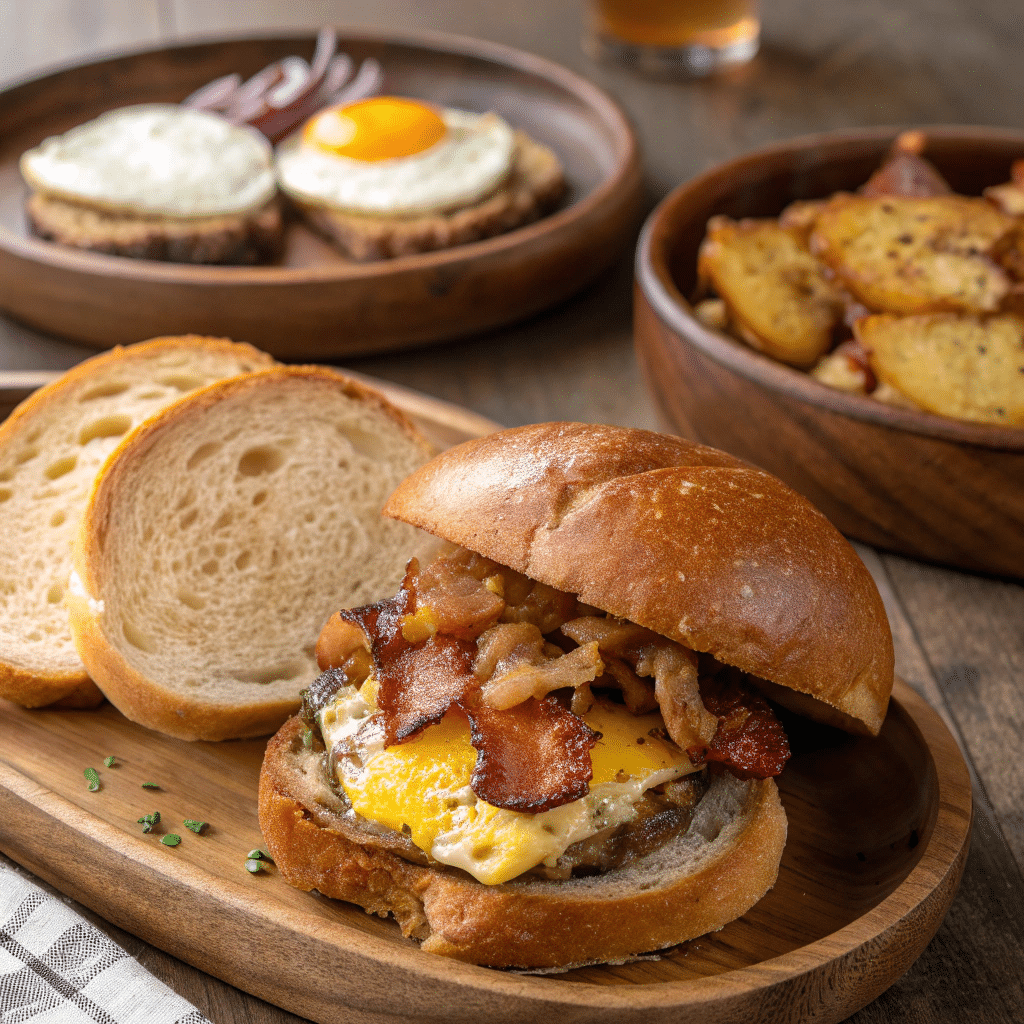
🧄 Sourdough Garlic Bread
Slice, butter, sprinkle garlic + herbs, and toast in the oven. Instant fancy appetizer.
🥗 Croutons or Breadcrumbs
Buns going a little stale? Cube them up and toss in olive oil for salad croutons—or blitz into breadcrumbs for meatballs or schnitzel.
🧀 Mini Sliders for Parties
Make a batch with smaller dough balls (about 60–65g each). Add cute toothpicks and impress all your friends.
🧁 Sweet Twist? Yup.
Brush with butter and sprinkle cinnamon sugar before baking for a light dessert-style roll. Weird? Maybe. Delicious? Absolutely.
Expert Advice from Real Bakers 🧠✨
Still skeptical? Let’s hear what some pros say about sourdough buns:
“The key to great sourdough hamburger buns is building strength into the dough early on—through folds and proper fermentation. Don’t skip those steps.”
– Maurizio Leo, author of The Perfect Loaf
source
“Long fermentation adds that signature depth to buns that commercial yeast can’t replicate. Plus, your gut will thank you.”
– Elaine Boddy, sourdough educator and author of Wholegrain Sourdough at Home
source
For more delicious recipes and cooking inspiration, follow me on Facebook, Pinterest and Reddit!
Storage & Reheating Tips
Let’s face it: homemade sourdough buns are gold. So you’ll wanna store ’em right and know how to revive them like fresh-from-the-oven magic.
🧊 Storing
| Method | How-To | Shelf Life |
|---|---|---|
| Room Temp | Keep in an airtight container or zip bag | 2–3 days |
| Freezer | Wrap each bun in plastic wrap + store in a freezer bag | Up to 3 months |
💡 Pro Tip: Freeze buns the same day you bake them for max freshness. You can even pre-slice them for faster toasting later!
🔥 Reheating
| Method | Instructions |
|---|---|
| Oven | 350°F (175°C) for 8–10 minutes (wrap in foil for softness) |
| Toaster | Slice bun and toast each side for crunch |
| Microwave | 10–15 seconds with a damp paper towel (if you’re in a rush) |
FAQ ( Sourdough Hamburger Buns )
Do I have to use sourdough starter?
Yes—for sourdough buns, a bubbly, active starter is the star of the show. But if you’re in a pinch, a hybrid version with commercial yeast can work.
Can I use all-purpose flour?
Totally! Bread flour gives more chew, but all-purpose still yields soft, tasty buns. You may need to adjust the hydration slightly.
Can I make the dough ahead?
Yes! After shaping, pop the buns in the fridge overnight. In the morning, let them come to room temp and puff up before baking. That slow proof = more flavor
How can I make the buns sweeter?
Easy—bump up the sugar or honey to 2 tablespoons. You can also brush the tops with honey butter after baking for dessert-style buns.
Why are my buns cracking on top?
Most likely: dry skin during proofing. Keep them lightly covered with plastic wrap or a damp towel. Also, don’t skip the final proof—rushing ruins rise.
Can I make these gluten-free?
Sourdough + gluten-free is trickier but doable with the right blend and a super active starter. Try buckwheat or sorghum-based blends, and know that texture may vary.
Can I make mini Sourdough Hamburger Buns for sliders or kids’ meals?
Yes! You can easily make mini Sourdough Hamburger Buns by dividing the dough into smaller portions—around 50–60g each. They’ll bake a little faster (about 15–18 minutes), and they’re perfect for sliders, party snacks, or lunchbox-friendly sandwiches. Same great flavor, just bite-sized and adorable! 😍
Sourdough Hamburger Buns
Golden, soft-on-the-inside, lightly tangy sourdough buns that hold their own against juicy burgers, breakfast stacks, or veggie patties. Bonus: they freeze beautifully.
- Prep Time: 30 minutes (active)
- Cook Time: 25 minutes
- Total Time: ~7–11 hours (mostly hands-off)
- Yield: 6–8 buns 1x
- Category: Bread, Buns
- Method: Baking
- Cuisine: American
- Diet: Vegetarian
Ingredients
- 100g active sourdough starter (100% hydration, bubbly and fed)
- 180g warm milk (or water for dairy-free option)
- 350g bread flour (or use part all-purpose if needed)
- 30g unsalted butter (softened, room temp)
- 15g sugar or honey (adds flavor and feeds the starter)
- 7g salt (don’t skip it – flavor + gluten strength)
- (Optional) 1 egg, beaten (for glossy egg wash on top)
- (Optional) Sesame seeds for topping
- (Optional) Swap 50g of bread flour with whole wheat flour for nuttier taste
Instructions
- Step 1: Feed Your Starter
Feed your sourdough starter about 4–6 hours before using.
Should be bubbly and pass the float test when ready. - Step 2: Mix Ingredients
In a large bowl, combine:
100g starter
180g warm milk
15g sugar or honey
Stir in:
350g bread flour
30g softened butter
7g salt Mix until a rough,
sticky dough forms. - Step 3: Autolyse (Optional but helpful)
Let dough rest for 30 minutes after initial mixing.
Helps develop gluten naturally before kneading. - Step 4: Knead & Stretch
Knead by hand or with dough hook for 3–5 minutes until smooth.
Or do 3–4 stretch & folds every 30 minutes during bulk ferment. - Step 5: Bulk Fermentation
Cover dough and let rise at room temp (4–6 hours).
Dough should puff up noticeably, especially after stretch & folds. - Step 6: Divide & Shape
Divide into 6–8 equal portions (about 80–100g each).
Shape into tight, smooth balls with good surface tension.
Place on parchment-lined tray with spacing. - Step 7: Final Proof
Let shaped buns rest 1–2 hours at room temp, or overnight in the fridge.
They should puff and jiggle slightly when touched. - Step 8: Bake!
Preheat oven to 375°F (190°C).
Brush with egg wash (if using) and sprinkle with sesame seeds.
Bake for 20–25 minutes until golden brown.
Internal temp should reach 200°F (93°C) for doneness. - Step 9: Cool & Serve
Let buns cool on a rack before slicing.
Store extras in airtight container (2–3 days) or freeze (up to 3 months).
Notes
- Don’t rush proofing. Underproofed = dense. Overproofed = flat. You want a gentle, jiggly puff.
- Use bread flour for chewy, structured buns. All-purpose works, but won’t be as tall.
- No milk? Sub water or plant milk. It won’t be as rich, but still delicious.
- Want them vegan? Skip the egg wash and use a plant-based milk wash with a drizzle of maple syrup
Nutrition
- Serving Size: 1 bun
- Calories: ~210
- Sugar: 2g
- Sodium: 290mg
- Fat: 5g
- Saturated Fat: 3g
- Unsaturated Fat: 2g
- Trans Fat: 0g
- Carbohydrates: 35g
- Fiber: 2g
- Protein: 6g
- Cholesterol: 20mg
Conclusion
There’s just something magical about pulling fresh Sourdough Hamburger Buns out of your oven—golden, warm, and whispering “add bacon and cheese.”
They’re not just tastier than store-bought (although… duh), they’re better for your gut, easier to freeze, and totally customizable for whatever culinary adventure you’re cooking up.
Once you get the hang of it, you’ll wonder how you ever survived without homemade sourdough buns in your life. Your burgers will thank you. Your brunch sandwiches will sing. And your kitchen? It’s about to smell really good.
So go ahead, start your starter, get that dough rising, and prepare for burger buns that might actually steal the show at your next cookout. 🍔🔥

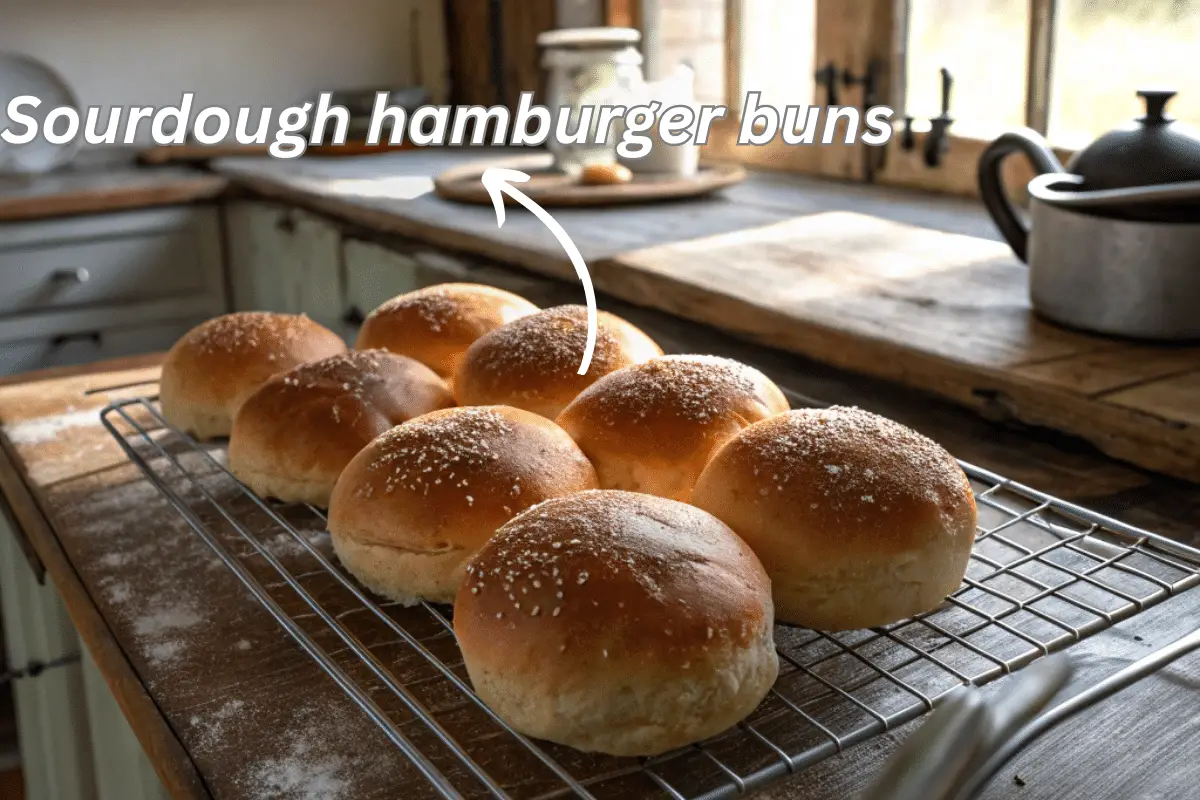

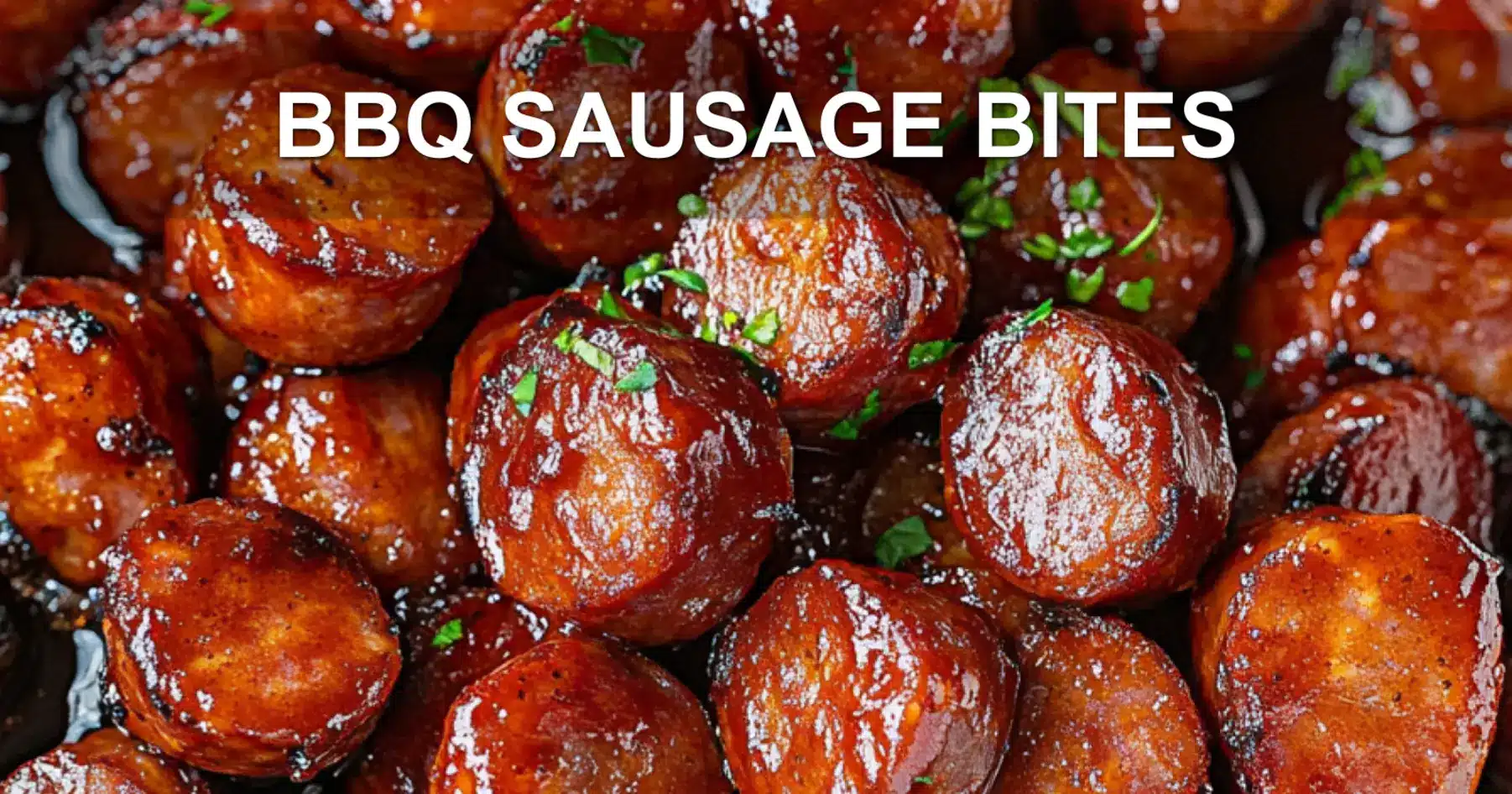

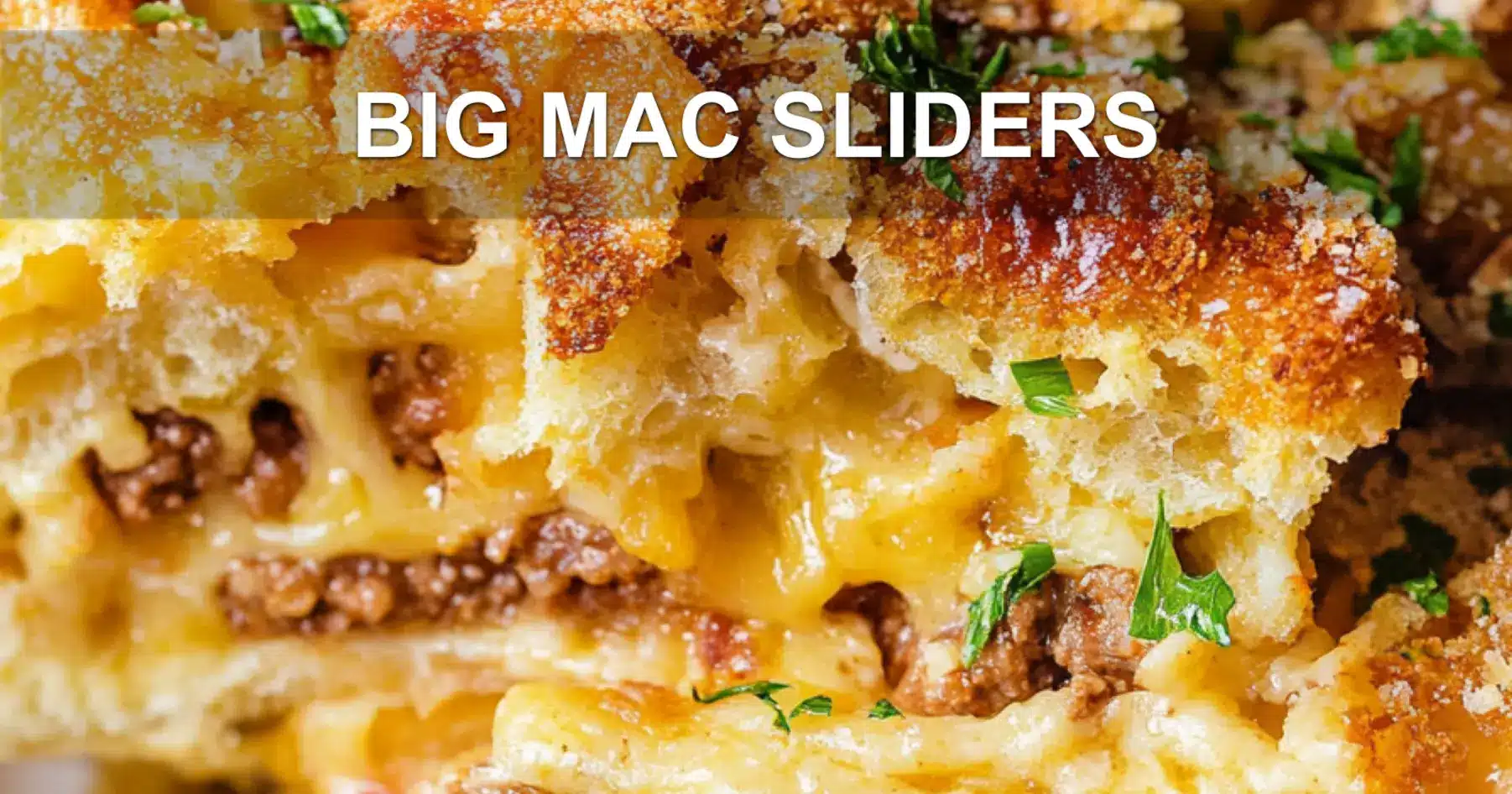



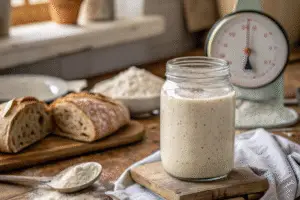


1 thought on “Sourdough Hamburger Buns: The Ultimate Homemade Upgrade”